Ultrabook Head to Head: Acer Aspire S3 vs. ASUS UX31E
by Jarred Walton & Manveer Wasson on December 21, 2011 5:40 AM ESTUltrabook Application Performance
We’ve really covered most everything that matters, as the core hardware is very similar. By this time you should have a good idea which ultrabook (if any) is right for you, but we still have benchmarks to run. We’ll start with our usual application performance metrics, skip the gaming tests (HD 3000 is sufficient for entry level gaming and that’s about it), and then looks at the battery life and display metrics. All of the ultrabooks we’ve tested have SSDs for storage, which really helps the general application performance; keep in mind that models that opt for an SSD+HDD hybrid solution (like the less expensive Acer S3) won’t have nearly the overall responsiveness. We’d just as soon Intel revise the ultrabook spec to mandate SSD storage only for the OS and apps (e.g. at least a 60GB SSD), but that ship has unfortunately sailed. Anyway, let’s hit the charts, starting with PCMark 7.
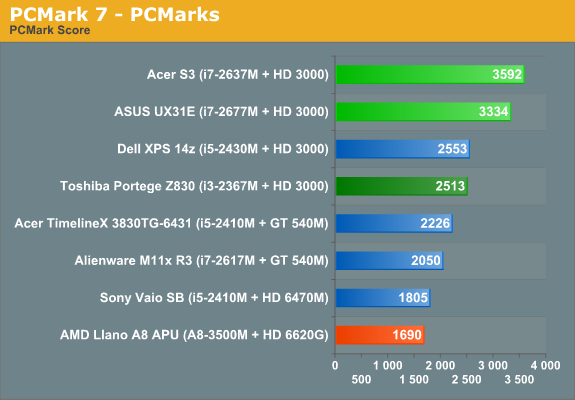

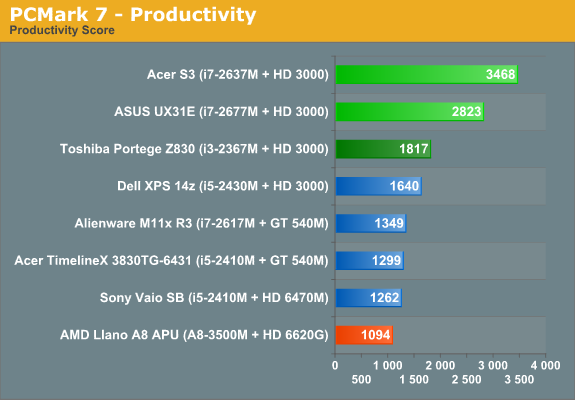
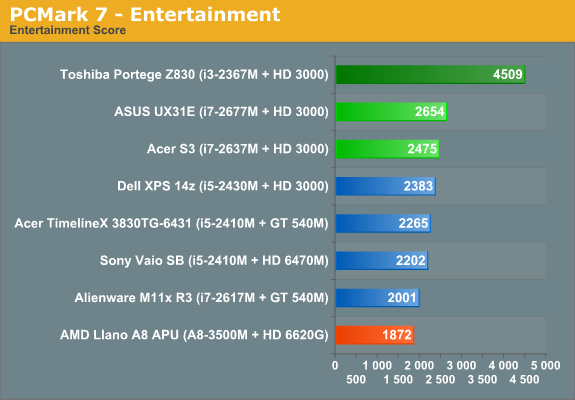

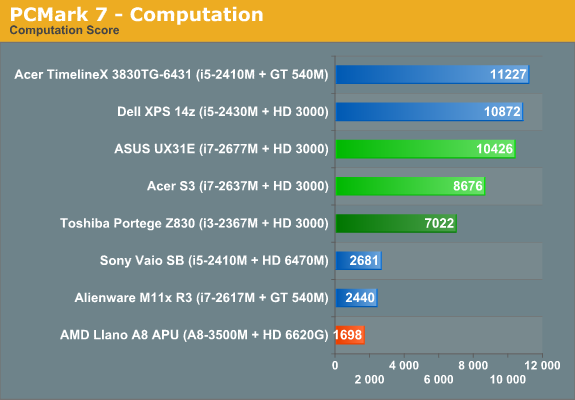
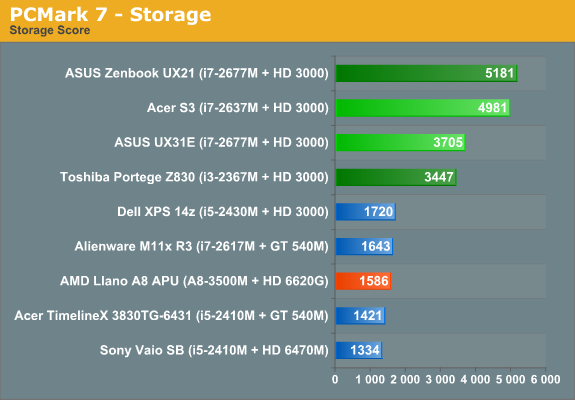
Our full set of PCMark 7 results is the most compelling view of using an ultrabook. They don’t have the raw compute power of a quad-core notebook or even a non-ULV Core i5, but for most tasks the ULV processors are plenty fast. Windows boots and shuts down very quickly, launching multiple applications simultaneously doesn’t grind performance to a halt, and even better you can mostly avoid the long-term performance degradation that usually comes with Windows and conventional hard drives. There are a couple other items of interest to point out with these results. First, the Micron C400 is clearly faster than the SanDisk U100 SSD; this manifests in many of the benchmarks, but the Storage suite in particular shows just how much of a difference there is. Also note that the UX21E we tested had a SandForce 2200 based SSD, and that’s why it also scores well despite only having 128GB (e.g. fewer NAND die). The other item to point out is that the ASUS shipped with newer Intel graphics drivers; usually such things don’t matter much, but here the updated drivers really boost the Quick Sync performance (and thus the Computation score) as well as some of the 3DMark results we’ll see below. Let’s hit the rest of the application benchmarks before we summarize things.
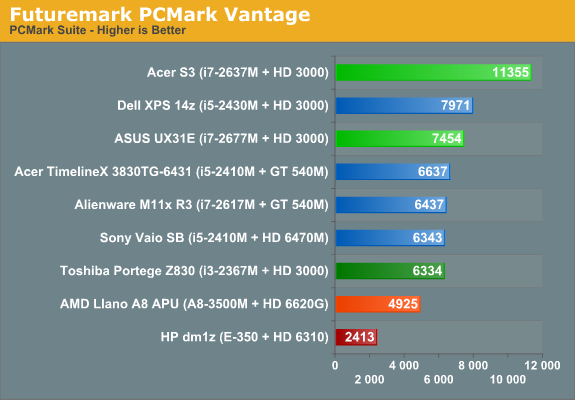
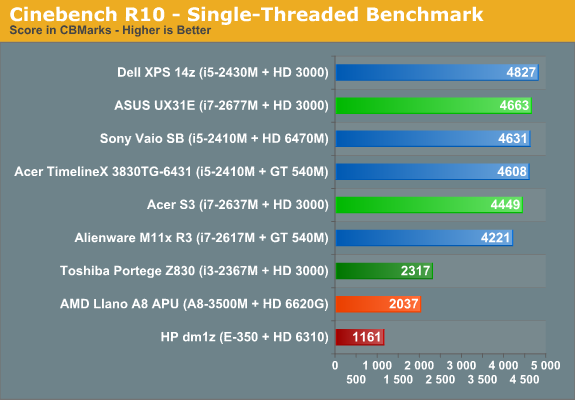
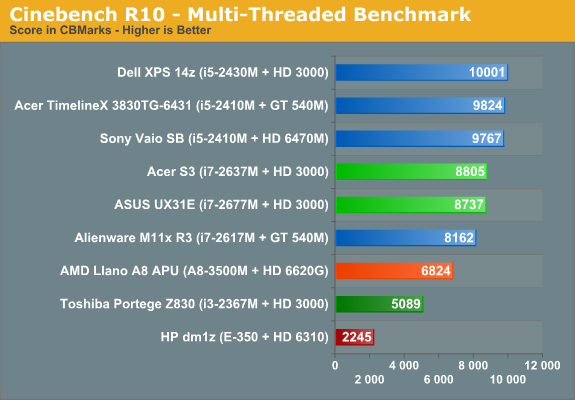
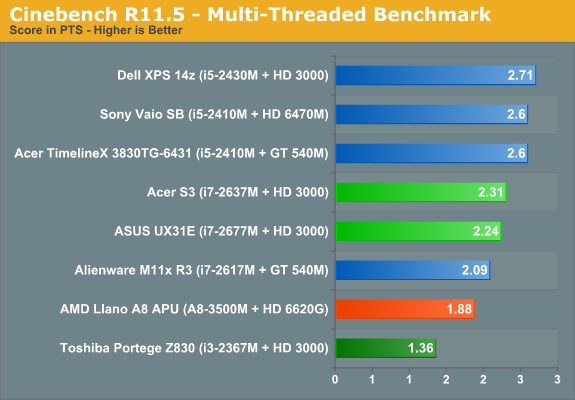
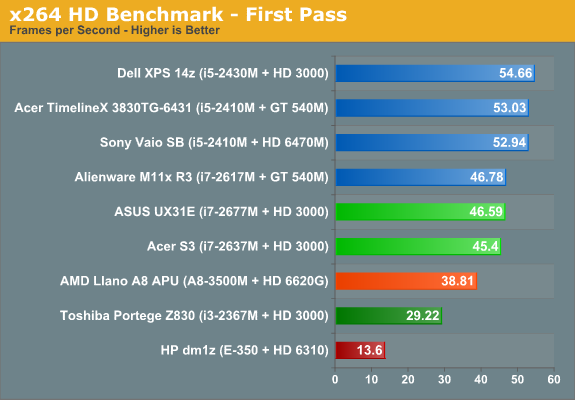
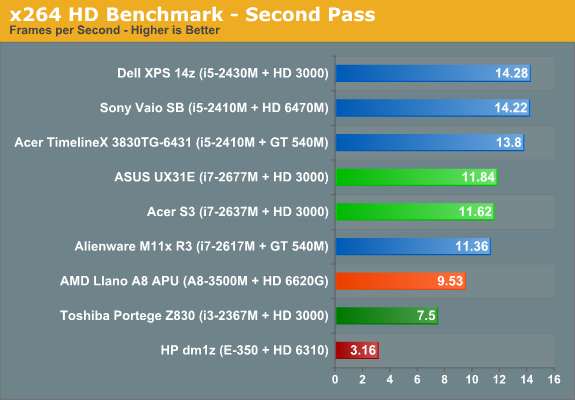
Once we get away from the SSD-centric tests like PCMark (Vantage appears particularly unkind to the SanDisk U100), performance falls out where you’d expect. With the high Turbo Boost modes available on the i7 ULV processors, the S3 and UX31E can actually give the 35W TDP Core i5 parts a run for the money, but if you put a sustained load on the CPU (which most of these tests do) you’ll see the clock speeds drop after the first 30-45 seconds. Generally speaking, even the OEM i5-2410M/2430M are faster than the i7-2677M in most tests, but that’s fine as the ULV parts are at least close and they still use half the power at full load. Taking a look at the AMD side of things, we’ll just skip Brazos—it’s there for reference, and since it ships in 13.3” laptops it’s a fair addition for low-power laptops, albeit one that costs half as much as an ultrabook. Llano on the other hand still comes out okay in performance comparisons; where it was clearly faster than the i3-2367M ULV part in multi-threaded scenarios, the Core i7 ULV parts regain the lead, but that’s not the entire story.
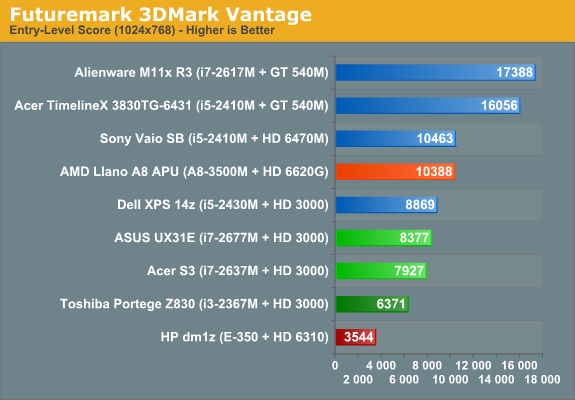
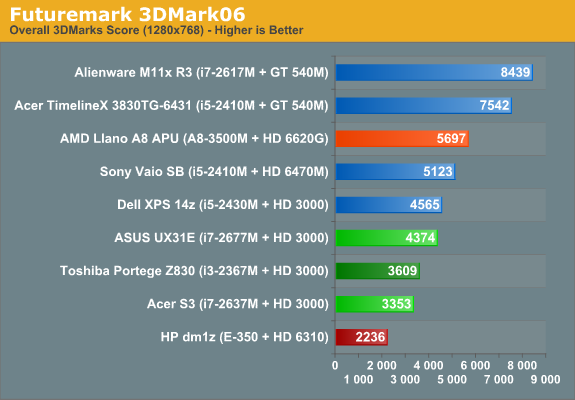
Rounding things out with 3DMark, the three ultrabooks place at the bottom of the charts. They’re faster than the E-350 IGP, but that part competes in a completely different price range so that’s okay; Llano on the other hand puts paid to anything without a discrete GPU. We’d still like to see A8-series APUs in laptops costing under $600, and Llano uses more power than the ULV chips and goes into thicker, better cooled laptops. Still, it’s a great budget laptop part if you care more about graphics than CPU intensive tasks. Give it an SSD for storage and it will hang with the ULV parts in many of the other tests as well.










81 Comments
View All Comments
JarredWalton - Thursday, December 22, 2011 - link
At 100 nits the UX31E has a white point of 93.39 and a black point of 0.44, giving a contrast of 212:1 -- basically it doesn't change.cobalt42 - Wednesday, December 21, 2011 - link
Thanks for the review.I just wanted to say I appreciate that you show a nice, direct picture of the keyboard layout and include some discussion of dedicated home/end/pageup/pagedown/insert/delete keys. That's the main thing keeping me away from MBAs, and these two don't get it quite right either. (Yes, I use those keys constantly. Chording is not acceptable when there's plenty of space on the keyboard for dedicated keys. And is that a power button KEY on the Asus? How often do you need to hit the power button that you need to waste an entire key for it? Insane.) The Toshiba Z830 has a good key layout, but too many other things wrong with it like the ridiculously low resolution.
tim851 - Friday, December 30, 2011 - link
I HATE it, when they place a dedicated row of Home/End/... buttons next to the keyboard. I tend to hit the Delete and Enter keys on the right edge and if that row is present, I will oftentimes hit one of its keys alongside the one I mesnt to press.That's why I find I have little choice when it comes to 13" laptops, because most of them have that dreaded row of keys.
Please, leave the few that don't, alone!
ccd1 - Wednesday, December 21, 2011 - link
Santa brought me an early Christmas gift of the Dell 15z. Santa had read the review here and ordered the 15z with only two upgrades, the 1080 display and a 256k SSD. Based on my brief use of this PC, I have these thoughts.Ultrabooks have the potential to expand portability to include larger machines. True portability stops at 14" right now, IMHO. It would be really nice to see a 15" ultrabook. The 15z kind of gets there, but not quite. A thinner, lighter 15z would definitely be more portable.
All of these machines need a really good docking station, ideally a combo laptop cooler and docking station. To have these machines double as desktops, would want one plug for the peripherals and be done with it. Right now I have my machine connected to a big display, keyboard, mouse, laptop cooler, mic, and HDD backup. The idea of plugging and unplugging all these peripherals to move the machine around is a real damper on portability. Love to have a docking station that plugs into the USB 3.0 port and be done with it.
r3loaded - Wednesday, December 21, 2011 - link
It's funny to note that the Asus Transformer Prime (practically the stylistic tablet equivalent of the Zenbook) has a far superior display compared to these ultrabooks that cost more than double. I hope Apple can push the industry forward instead of letting them race to the bottom on displays.ibtar - Wednesday, December 21, 2011 - link
Pretty sure we've already hit rock bottom as far as LCD quality goes, at least in laptops. Only place to go from here is up, but who knows when that'll happen.Death666Angel - Wednesday, December 21, 2011 - link
Coming from a Travelmate 8172, my next notebook needs to look similar to:- 2 core CPU between 1.5 and 2.5GHz (4 threads optional)
- integrated GPU to play HL2-ish titles at native resolution and medium settings
- 128GB SSD (performance on par with first SF-Generation or better) (mSATA SSD + 2.5" HDD optimum)
- 4 GB RAM (8 GB optional)
- matte 12.1" to 13.3" LCD with 1600x900 (good brightness appreciated, contrast and color replication secondary)
- weight below 1.5kg
- thickness anything under 3cm, length and width as the display allows plus medium bezel
- no ODD
- trackpad area separated from rest of the chassis, keyboard keys as big as possible for the chassis
- 60Wh battery fully replaceable by the end user
- Intel WLAN adapter with 300+Mb/s, 2.4GHz/5GHz dualband (3G not needed)
- 2xUSB 3.0, 2xUSB 2.0, 1 Gb Ethernet and/or Thunderbolt
Price can be between 800€-1200€, depending on actual components.
What I will not buy anymore: 1366x768 in anything above 11.6", glossy LCD, anything without either USB 3.0 or Thunderbolt.
Snotling - Wednesday, December 21, 2011 - link
not ever again (unless its a smart phnoe)retrospooty - Wednesday, December 21, 2011 - link
"NOT going under 900p"Ditto.
Any product at all when I see 1368x768 I immediately tune out. So tired of that low res as a standard.
One good thing you gotta give Apple, is the retina display. To me its overkill for a phone, but if it can help to usher in the end of 1368x768 laptops then I applaud them. Thank you Apple!
nphewitt - Wednesday, December 21, 2011 - link
Apple uses MagSafe connectors, not MagLock. Kleenex vs Tissue, whatever. Just putting it out there.